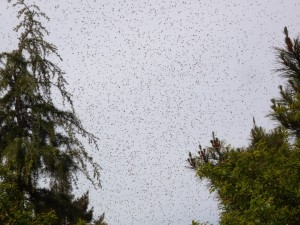Arriving to inspect one of our hosted beehives this past Saturday, the host informed me that the bees had been more noisy that morning than she’d ever heard them. She went on to say that a football-sized group of them had been hanging off the front of the hive. Hmmm…
I looked around the yard in case the swarm had alighted somewhere near the ground. I saw no sign of the bees and proceeded with the inspection. Activity around the front of the hive looked normal enough, with a steady stream of bees going in and out. A few drones loafed around, but I didn’t see any worker bees fanning and milling at the entrance, as I have in other hives that have just swarmed.
Onsite equipment
–Eight-frame Langstroth (all deeps) with eight frames per box, three boxes total.
Hive lineage
–Swarm (probably from a feral colony) settled in a bait hive in an oak woodland habitat around May 14, 2012.
–Hived in Emerald Hills, CA.
–Swarmed and split March 23, 2013.
On with the hive inspection
Opening the hive, I immediately found closed queen cells hanging from the bottoms and in the middle of frames in the third (uppermost) box. I found almost exclusively capped worker brood (no eggs or uncapped larvae, and minimal drone brood), quite a bit of honey, and very minimal pollen.
“I hear that noise again,” the host exclaimed. She had been sitting nearby to watch the excitement and provide moral support. I looked up and saw a cloud of bees rising above the neighbor’s yard. Egad! Swarming is such an awesome spectacle. We watched for several minutes as the bees moved toward us and then away, finally vanishing from sight behind a stand of trees. Honey bee swarms remind me of schools of airborne fish.
Had I only gotten out to inspect a few hours earlier I might have easily collected them hanging off the front of the hive. Ah well…
Splitting the hive
Because we like these bees a whole lot (mild mannered, good honey producers, strong numbers), and because there were so many queen cells (8-10 in the top box?) and so many bees left in the hive, I decided to go ahead and split. Disclaimer: I don’t really know what I’m doing and hope the bees will forgive me my many foibles.
I figured I would attempt to approximate the configuration of our first hive split. I took two frames with queen cells, capped brood and honey, along with a frame mostly full of capped honey (some small amount uncapped) and the frame with the most pollen I could find (really only about one third of one side of the frame) and placed them in a new hive body. The frames had a decent number of bees on them, though they were not 100% covered. I also shook an additional frame of bees over the box. I’m a little worried about whether or not the split has enough bees and food to tide it over until more workers hatch out and allow the nurse bees to graduate to foragers. We’ll see.
I also wondered if, given that the original hive is presumably queenless after the swarm, foragers who ended up in the split might not be as motivated to jump ship and return to their mother hive. I don’t have an answer for this, or even a way to really tell when we go back to inspect.
I consolidated the remaining frames of brood in the original hive and added four new frames with foundation. I also took a peek in the second box. From what little I saw, it appeared to be more capped brood.
Kelly is out of commission with a hurt knee, and I’ve been roughing it alone on inspections. Lifting heavy boxes and retrieving tools solo has proved challenging, and I left the inspection at that. I will be back to add another box to the original hive soon, but we’ll wait to disturb the split for about a month. Here’s wishing them well.




4 Responses to A Swarm and a Split